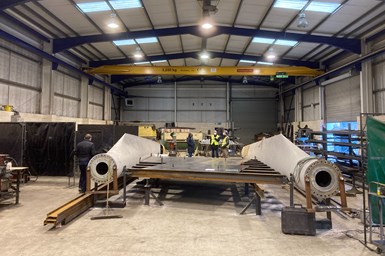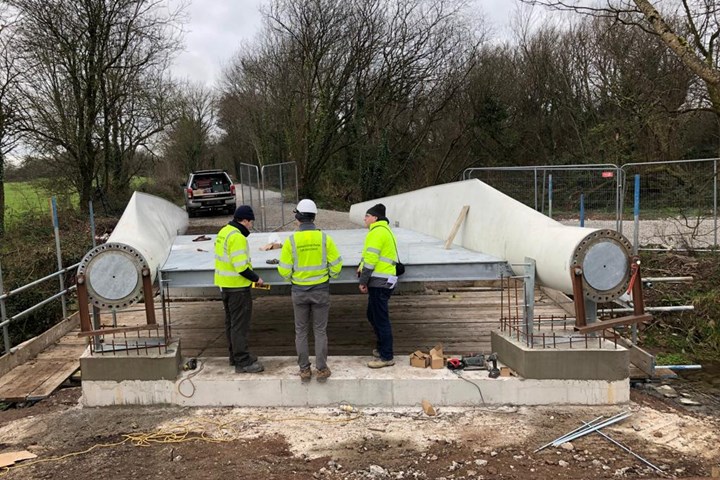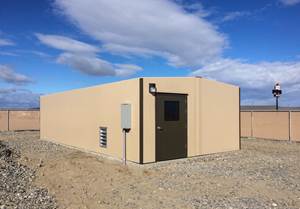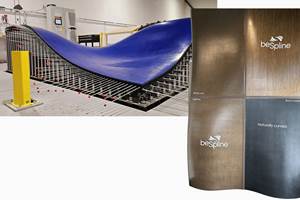Re-Wind Network successfully installs repurposed wind blade pedestrian bridge
The Ireland-based, five-meter-long BladeBridge solution has undergone extensive materials and mechanical testing to ensure application suitability.
On Jan. 26, the Re-Wind Network — comprising the University College Cork, Queens University Belfast, Georgia Tech and Munster Technological University (MTU) — announced the successful installation of a wind blade pedestrian bridge (BladeBridge) in Cork, Ireland, with remaining landscaping, removal of shoring platform underneath and handrail assembly to be completed shortly. The structure is one of two repurposed end-of-life (EOL) wind blade solutions initially designed and rendered in its fall 2021 Re:Wind Design catalogue, and was additionally designed to have the capacity and width to carry maintenance or emergency vehicles. Completion of the second demonstration, a wind blade power pole (BladePole) located in Kansas is planned for summer 2022.
The BladeBridge was originally funded in 2019 under the Irish Government Department of Transport’s “Project Ireland 2040” initiative, one of many opportunities identified by MTU to build a blade bridge on a long-distance pedestrian and cycle route in the Midleton-Youghal Greenway, a location which is under development by Cork County Council to improve rural development, tourism and public health. It uses two repurposed LM 13.4 wind blades from Nordex (Rockstock, Germany) N29 turbines originally donated by Everun Ltd. (Belfast, Northern Ireland) for its main girders. The remaining tip of the of the blade is embedded into the ground.
Final installation required experimental testing, computational modeling and design work to ensure the fiber-reinforced polymer (FRP) wind blades were suitable for use as girders for a short-span pedestrian bridge. Out of a total of eight blades donated by Everun, five were placed temporarily in storage, two were kept for the BladeBridge fabrication and one was delivered to the MTU structures laboratory for testing.
Extensive materials and mechanical testing, such as resin burnout tests (conducted in accordance with ASTM D2584 (ASTM 2011)) to determine how the material properties varied along the length of the blade, and mechanical testing in tension and compression were performed. Additionally, a four-point edgewise bending test was carried out on a four-meter section of the wind blade to evaluate its load-carrying behavior.
Software was also developed by the Re-Wind team called “BladeMachine” used to generate the engineering properties of the blade at multiple sections along the blade length. Preliminary designs considered architectural and structural requirements, including different orientations and placements of the wind blades (below deck, cable-stayed, etc.), connecting the stringers and deck to the blades and aesthetic details including the guardrail design, deck height, blade length and construction materials.
“This project would not have been possible without the vision and the enthusiastic support of the Cork County Council,” says Larry Bank, industry-academic outreach, The Re-Wind Network. “The Re-Wind Network is immensely proud of our Irish team at MTU and UCC led by Kieran Ruane and Angie Nagle.”
Related Content
Composite buildings go monocoque
Superior protection from the elements plus fast, affordable installation and maintenance have quickly made Orenco Composites’ DuraFiber buildings an attractive choice for water and wastewater, communications, transportation and power industry outbuildings.
Read MoreComposites-reinforced concrete for sustainable data center construction
Metromont’s C-GRID-reinforced insulated precast concrete’s high strength, durability, light weight and ease of installation improve data center performance, construction time and sustainability.
Read MorePlant tour: BeSpline/Addcomp, Sherbrooke, QC, Canada
Composites automation specialist increases access to next-gen technologies, including novel AFP systems and unique 3D parts using adaptive molds.
Read MoreCirculinQ: Glass fiber, recycled plastic turn paving into climate solutions
Durable, modular paving system from recycled composite filters, collects, infiltrates stormwater to reduce flooding and recharge local aquifers.
Read MoreRead Next
CW’s 2024 Top Shops survey offers new approach to benchmarking
Respondents that complete the survey by April 30, 2024, have the chance to be recognized as an honoree.
Read MoreComposites end markets: Energy (2024)
Composites are used widely in oil/gas, wind and other renewable energy applications. Despite market challenges, growth potential and innovation for composites continue.
Read MoreFrom the CW Archives: The tale of the thermoplastic cryotank
In 2006, guest columnist Bob Hartunian related the story of his efforts two decades prior, while at McDonnell Douglas, to develop a thermoplastic composite crytank for hydrogen storage. He learned a lot of lessons.
Read More













.jpg;maxWidth=300;quality=90)














